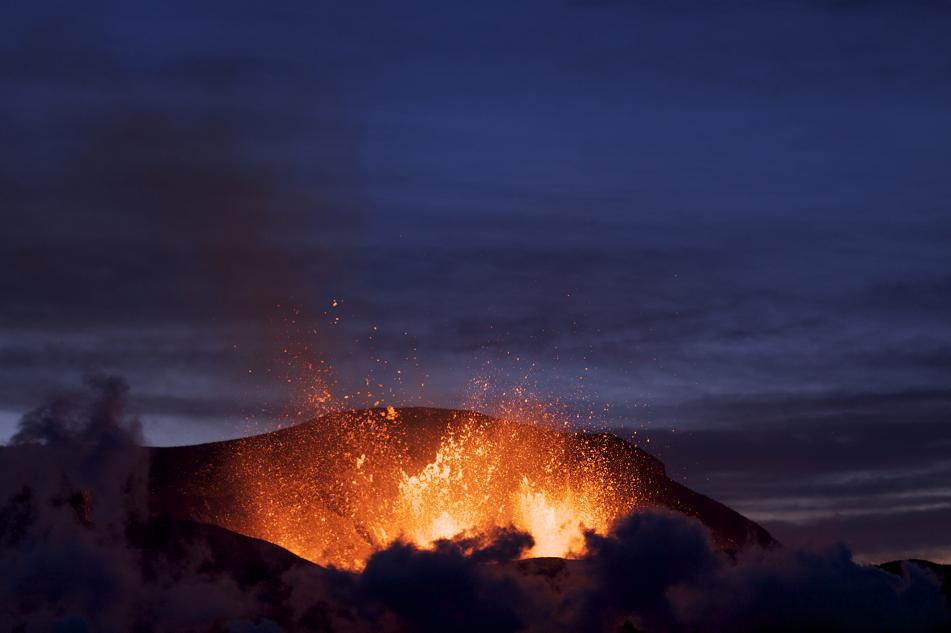This is how Prof. Akiva Flekser of the Department of Geophysics at Tel Aviv University describes the environment of the volcano in Iceland which recently erupted and caused disruptions in aviation in Europe in recent days

For previous news on the subject: The eruption of the volcano in Iceland intensifies, The European Space Agency photographed the ash cloud covering Europe
according to Wikipedia The Central Atlantic Ridge is a central oceanic ridge, mostly underwater, that extends in the Atlantic Ocean and the Arctic Ocean, from latitude 87° North, about 333 km south of the North Pole, to Bova Island at latitude 54° South. The high peaks of the ridge protrude above sea level and form islands, the largest of which is Iceland. Other islands along the ridge are Jan Mayen, Azores, Ascension, Tristan de Cunha and Goff Island.
In a conversation with the Hidan site, Prof. Akiva Flekser from the Department of Geophysics and Planetary Sciences at Tel Aviv University says that the Mid-Atlantic Ridge is constantly stalling and pushing Europe and Africa to the east and the two Americas to the west. This ridge has been active for nearly 200 years.
Since this is a fissure line, a stretching movement is actually taking place as the crust actually becomes thinner and thinner as the mass migrates in the two opposite directions. In this thin area, it is easier for magma - the hot material found deep within the earth - to break through the crust, and the result is the activity of volcanoes along the ridge in the center of the Atlantic Ocean and in Iceland itself. And so a chain of underwater volcanoes was created for it which, as mentioned, sticks out only in a few places, with the most well-known bulge being Iceland and also a relatively new product of the ridge - about 20 million years. In Iceland you can clearly see how the score is expanding all the time. If so, Prof. Flekser points out that it is not a straight fissure like a ruler, but a whole area full of fissures, some of them parallel.
Volcanic eruptions are very common in Iceland although not always on a large scale. However, one of the outbreaks, in the 19th century, also covered all of Europe, but in the absence of air transport, the damage was not so great. By the way, a little south of the volcano that erupted this time, another volcano called Hela erupted, and a town called Amy burned completely a few decades ago in this eruption. Even now, the authorities had to evacuate hundreds of residents whose houses were in a dangerous area for flooding. Many roads and fields were covered in rivers of mud.
An interesting example of such an eruption was in 1963, when before the eyes of Icelandic fishermen huge rocks erupted from the water. The volcanic eruptions continued for four years and after a ceaseless struggle between the trend that tried to conquer the area and the sea that tried to cover it, the trend won and a black virgin island was born that exists to this day and was named Sarzi.
In the 19th century, several unusual volcanic events were recorded. A volcano called Toba between Sumatra and Java in Indonesia erupted on August 15, 1814 and European dust and ash reached Europe and caused the cancellation of summer. The famous English poet Lord Byron wanted to be freed from the grayness and cold of the British Isles and went to rest in Lake Geneva, where the sudden winter caught him, and it brought him to write the poem DARKNESS. Towards the end of that century, in 1883, the Catau volcano erupted, also in Asia, and the ash that stayed in the atmosphere for a long time caused spectacular sunsets in San Francisco.
In the 17th century BC, that is, about 3,500 years ago, a volcano erupted in Tira, north ofSantorini and caused the retreat of the Minoan culture. The legends about ash and darkness were preserved thousands of years later in the Bible as two of the ten plagues of Egypt: boil (when, according to the Bible, Moses and Aaron raised their hands and ash fell from them) and of course a plague of darkness that resulted from the concealment of the sky by the volcanic ash.
The forecaster Boaz Dayan, Editor of the Israel Weather website Points out that in connection with the Pinatubo volcano that erupted in 1991 and caused the winter of that year to be rainy, and which we referred to in the previous articles, that then the column of ash erupted to a height of 34 kilometers where there are no rain clouds and therefore it was not washed away. This time it is 9-10 kilometers, a height where there are still clouds and therefore they may be washed away in one of the upcoming rain events, regardless of the amount.
More on the subject on the science website
- The sky in the Scream painting is red because of the eruption of a volcano half a world away from Europe
- Can we send robots to Earth's surface?
- A NASA satellite photographed the emission of smoke from the eruption of Mount Athena in Sicily on October 29, 2002 at an altitude of over one hundred kilometers
- When the earth attacks

4 תגובות
There were only 5-7 km left to cross the tropopause and we would enter the stratosphere and circle each field
"A
Boaz Dayan is not a forecaster but a weather enthusiast.
Boaz Dayan is not a certified forecaster but a weather enthusiast.